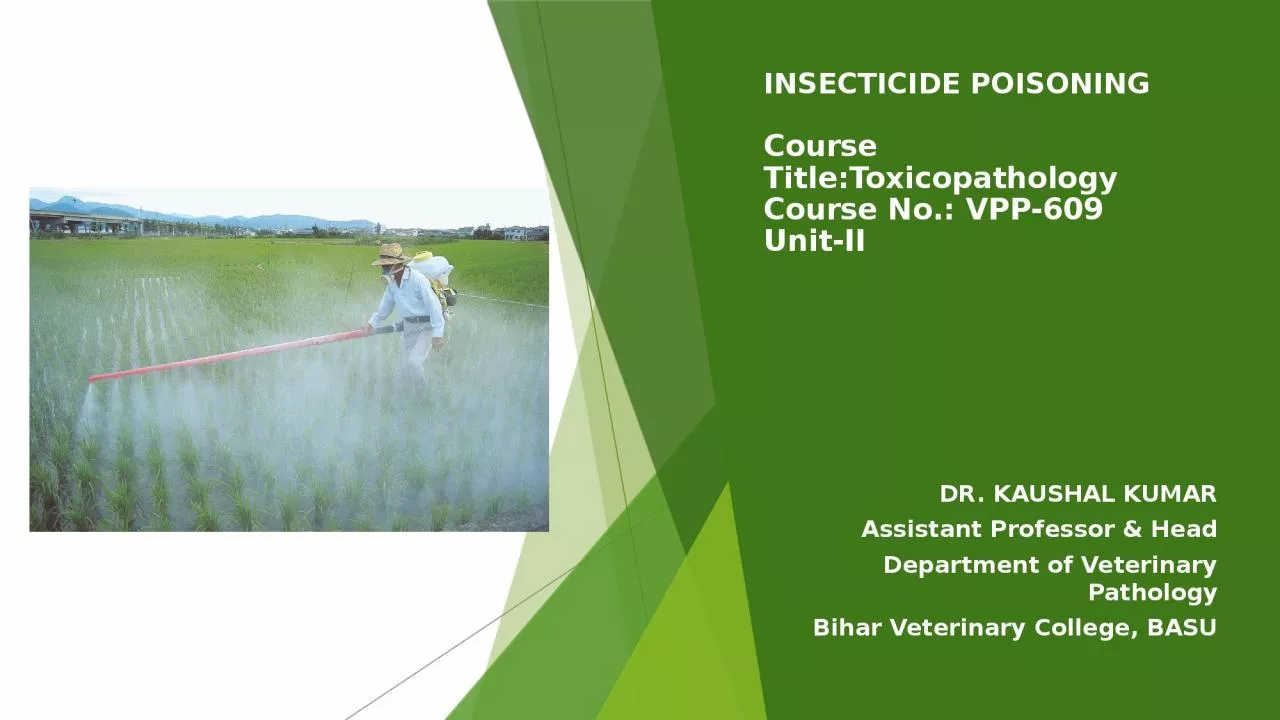

TitleToxicopathology Course No VPP609 UnitII DR KAUSHAL KUMAR Assistant Professor amp Head Department of Veterinary Pathology Bihar Veterinary College BASU Insecticides are substances used to kill ID: 928116
Download Presentation The PPT/PDF document "INSECTICIDE POISONING Course" is the property of its rightful owner. Permission is granted to download and print the materials on this web site for personal, non-commercial use only, and to display it on your personal computer provided you do not modify the materials and that you retain all copyright notices contained in the materials. By downloading content from our website, you accept the terms of this agreement.
Slide1
INSECTICIDE POISONING
Course
Title:Toxicopathology
Course No.:
VPP-609
Unit-II
DR. KAUSHAL KUMAR
Assistant Professor & Head
Department of Veterinary Pathology
Bihar Veterinary College, BASU
Slide2Insecticides are substances used to kill insects.They include ovicides and larvicides used against insect eggs and larvae, respectively. Insecticides
are used in agriculture, Livestock farmer. Insecticides are claimed to be a major factor behind the increase in the 20th-century's agricultural productivity.Nearly all insecticides have the potential to significantly alter ecosystems; many are toxic to humans and/or animals; some become concentrated as they spread along the food chain.Introduction
Slide3ETIOLOGYon the basis of chemical nature, insecticides are classified as a) Organochlorine ex: DDT, Aldrin, Lindane.b) Organoposphorus
ex: Parathion, sumithion, and malathionc) Carbamate ex: aldicarb and carbaryld) Synthetic pyrethroid ex: cypermethrin Permethrin.
Clinical Aspect of Insecticide poisoning
Slide4Organochlorines Insecticides Toxicity: Mech. Of toxicity: They are neuro-poisons. By virtue of their high lipid sohibility, they easily enter the neural membrane and interfere with sodium-
pottasium Channel of membrane and some time (lindane) by inhibiting GABA-dependent Cl influx. Clinical symptoms: Dichloro-diphenylethane (DDT) poisoning causes initial stimulation of CNS followed by depression and death due to respiratory failure. In chromic poisoning, liver damage, hypoglysemia and hyperkalemia
may be noted. Symptoms of aldrin poisoning is more server then DDT characterised by teeth grinding, dyponea and frequent urination etc.Necropsy Lesion: No specific lesion in the nervous system. However acute Aldrin poisoning may cause hepatitis and acute tubular nephrosis. In
chromic case centrilobular necrosis may be noted.Diagnosis: 1)On the basis of history, sign and PM lesson2)Analysis of feed and or blood/milk sample and morbid specimen.
3)Differential diagnosis from : salt, strychnine fluroacelate poisoning.
Slide5Organo Phorphorus Insecticides Toxicity: On the basis of their activities OPI are classified as
a)Direct activity OPI ex: dichlorvos, TEPP, chlorothion anilophos.b)Indirect Acting OPI ex: Malathion, Parathion.
Slide6Carbamate Insecticides Toxicity: Mechanism of toxicity: Carbmates are potent and reversible inhibitors of cholinesterase enzyme whereas
AChe inhibition by OPIs is irreversible. Clinical Sign: are similar to that of OPIs but poisoning by carbamates is less sever and effects do not last long.PM Lesion: Limited to congestion and edema of lung liver and kidney.
Slide7Synthetic Pyrethroids Insecticides Toxicity: ex: Cypermethrin and Permethrin *Mechanism of Toxicity
: It is synthetic neuropoison and maintarget of actionis the nerve membrane sodium channel. *Clinical sign: of acute poisoning in lab animals are restlessness, incoordination, hyperactivity, tremor, prostration and paralysis and overall it is referred as T-syndrome. *Diagnosis
on the basis of clinical signs. Almost identical symptoms seen in any organochlorin poisoning.
Slide8References: https://www.msdvetmanual.com/toxicology/lead-poisoning/overview-of-Insceticides
Slide9